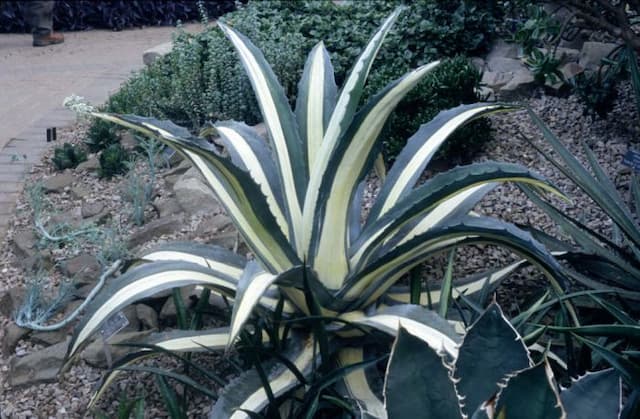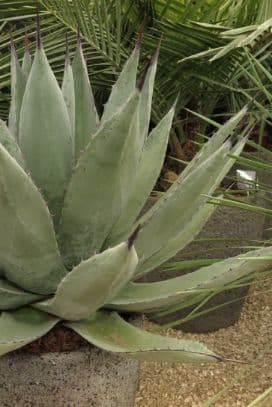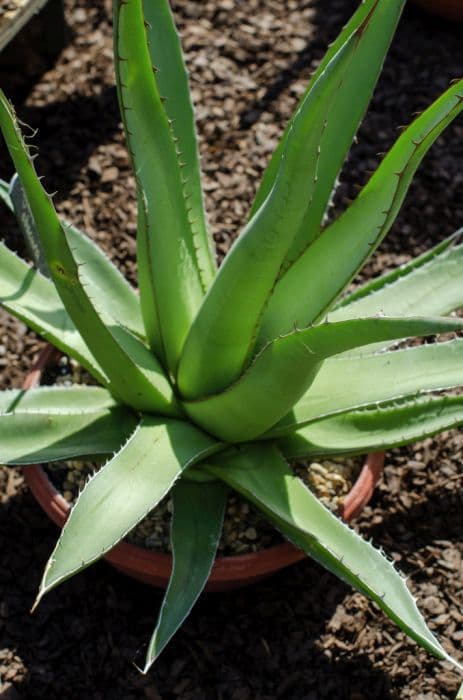Plantain Lily Hosta 'Catherine'

ABOUT
Hosta 'Catherine' is characterized by its lush foliage, which forms an attractive mound of leaves. The leaves themselves exhibit a captivating variegation. The base color is typically a soft green, and this can be overlaid with cream or yellowish margins that can form intricate patterns or edge the leaves with a bright contrast. The texture of the leaves is another notable feature; they can be quite thick and have a noticeable vein structure that gives them a quilted or corrugated appearance. In terms of shape, the leaves are generally heart-shaped or broadly ovate and often come to a gentle point. They also have a slightly wavy edge which can add to the overall texture and visual interest of the plant. During the blooming season, Hosta 'Catherine' produces flower stalks that rise above the foliage. The flowers are typically bell-shaped and can be a range of colors, commonly shades of purple or white. These blossoms are often fragrant and can attract pollinators like bees to the garden. The contrast between the subtle colors of the foliage and the brighter flowers can create a pleasing effect in a shaded garden area or woodland setting. Hosta 'Catherine', like other hostas, is primarily valued for its foliage and the way it fills the space with its dense and decorative leaves.
About this plant
 Names
NamesFamily
Asparagaceae
Synonyms
Plantain Lily, Funkia
Common names
Hosta 'Catherine'.
 Toxicity
ToxicityTo humans
Hostas are generally not considered toxic to humans. However, if ingested in large quantities, they might cause mild stomach upset or an allergic reaction in some individuals. The symptoms are typically not severe.
To pets
Hostas, including the variety 'Catherine', are toxic to pets such as dogs and cats. If ingested by pets, it can cause symptoms like vomiting, diarrhea, and depression. In severe cases, it could potentially lead to more serious complications like an increased heart rate or issues with the nervous system. If you suspect your pet has eaten part of a hosta plant, you should contact your veterinarian.
 Characteristics
CharacteristicsLife cycle
Perennials
Foliage type
Deciduous
Color of leaves
Variegated
Flower color
Lavender
Height
1 foot (0.3 meters)
Spread
3 feet (0.9 meters)
Plant type
Herb
Hardiness zones
3
Native area
Asia
Benefits
 General Benefits
General Benefits- Aesthetic Appeal: Adds lush foliage and texture to garden beds with its attractive green leaves that often have variegated patterns.
- Shade Tolerance: Thrives in shaded areas where many other plants struggle, making it an ideal ground cover for woodland gardens.
- Low Maintenance: Requires minimal care once established, making it a good choice for busy gardeners or those looking for low-effort landscaping options.
- Drought Resistance: Once established, Hostas can tolerate periods of dryness, reducing the need for frequent watering.
- Pest Resilience: Shows resistance to pests and diseases, ensuring the plant remains healthy with little intervention.
- Seasonal Interest: Offers a long season of interest from spring through fall, with foliage that lasts and sometimes flowers that add a splash of color.
- Soil Adaptability: Adapts well to a broad range of soil types, although it prefers moist, well-draining soil.
- Easy Propagation: Can be easily divided to create more plants, allowing gardeners to expand their garden or share with others.
- Wildlife Attraction: Though the blooms are often modest, they can attract pollinators like bees to the garden.
- Versatility in Landscaping: Works well in borders, as a groundcover, or in containers, making it versatile for various landscape designs.
 Medical Properties
Medical PropertiesThis plant is not used for medical purposes.
 Air-purifying Qualities
Air-purifying QualitiesThis plant is not specifically known for air purifying qualities.
 Other Uses
Other Uses- Creating a shady garden tapestry: Hosta 'Catherine' can be used in combination with other shade-tolerant plants to create a visually engaging garden that thrives without direct sunlight.
- Enhancing water features: The lush foliage of Hosta 'Catherine' can be planted around ponds or streams to create a naturalistic setting and soften hard edges.
- Pressing leaves for artistic projects: The leaves of Hosta 'Catherine' can be pressed and used in crafting, such as card making or botanical prints, due to their attractive shape and vein patterns.
- As a contrasting plant in a rock garden: The Hosta 'Catherine' can serve as a soft contrast to the hard textures of a rock garden while providing a pop of greenery in the space.
- Naturalizing woodland areas: Hosta 'Catherine' can be used to fill in spaces in woodland gardens, creating a thick groundcover that reduces weed growth.
- Accenting borders and pathways: This plant's foliage can be used to line pathways or garden borders to create an organized and lush garden appearance.
- Hosta leaf compost: Fallen Hosta 'Catherine' leaves can be added to a compost pile to enrich the compost with valuable nutrients as they decompose.
- Mood enhancement in stressful environments: Planting Hosta 'Catherine' in areas where calm and tranquility are desired, such as around seating areas or in a contemplative garden, due to their soothing green foliage.
- Educational purposes: Hosta 'Catherine' can be used in educational settings to teach about plant growth patterns, shade tolerance, and basic horticulture.
- Photography backdrop: The uniform and lush greenery of Hosta 'Catherine' can serve as a natural backdrop for garden photography or for taking pictures of small objects.
Interesting Facts
 Feng Shui
Feng ShuiThe Hosta is not used in Feng Shui practice.
 Zodiac Sign Compitability
Zodiac Sign CompitabilityThe Hosta is not used in astrology practice.
 Plant Symbolism
Plant Symbolism- Devotion: The Hosta 'Catherine', commonly known as Hosta, symbolizes devotion due to its hardy nature and the way it returns faithfully each year.
- Friendship: With its lush foliage, the Hosta plant is often associated with friendship, representing the growth and comfort that friendships provide.
- Resilience: Hostas are tough plants that can thrive in shade, symbolizing resilience and the ability to prosper despite challenges.
- Patience: They take time to grow and mature, representing the virtue of patience in personal growth and life.
 Water
WaterHostas, including the 'Catherine' variety, need consistent moisture especially during their growing season in spring and early summer. It is best to water deeply rather than frequently, providing about 1 inch of water per week if there hasn’t been sufficient rainfall. This often translates to around 0.5 gallons per square foot per week, although this can vary slightly depending on the soil type and weather conditions. In hot or dry weather, you may need to increase the frequency to maintain soil moisture, but always be careful not to overwater as hostas are prone to root rot. During the fall and as temperatures begin to drop, you can reduce watering as the plant prepares for dormancy.
 Light
LightHostas, like 'Catherine', thrive in partial to full shade. They prefer a spot that receives some morning sun followed by shade for the rest of the day, which helps to highlight their leaf color without causing scorching. Hostas can also grow in dense shade but might not produce as many flowers, and their growth could be less robust. It’s important to avoid direct afternoon sunlight, as this can burn the leaves of the plant.
 Temperature
TemperatureHostas, including the cultivar 'Catherine', are resilient in a wide range of temperatures but grow best when the average temperature is between 50 and 75 degrees Fahrenheit. They can survive in temperatures as low as 30 degrees Fahrenheit during their dormant state in winter and can endure summer highs up to 90 degrees Fahrenheit. However, prolonged exposure to temperatures outside of their ideal range can stress the plants and affect their growth.
 Pruning
PruningPruning hostas like 'Catherine' mainly involves removing the flower stalks once they have finished blooming, to tidy up the plant and redirect energy to the foliage. Additionally, it's a good practice to remove any damaged or yellowing leaves throughout the season to keep the plant healthy. The best time to prune is in late fall or early winter, when you can cut back the foliage to ground level after it has died back, preparing the hosta for its dormancy period.
 Cleaning
CleaningAs needed
 Soil
SoilHosta 'Catherine', commonly known as hosta, thrives best in well-draining soil that's rich in organic matter. The ideal pH for this plant is slightly acidic to neutral, from 6.5 to 7.5. A good soil mix would consist of equal parts garden soil, peat moss, and perlite or vermiculite to improve aeration and drainage.
 Repotting
RepottingHostas, including the variety 'Catherine', don't need to be repotted frequently. They can stay in the same pot for several years. Repotting should be done every 3-5 years or when you see signs that the plant has outgrown its current container, such as roots growing through the drainage holes.
 Humidity & Misting
Humidity & MistingHosta 'Catherine' is tolerant of a wide range of humidity levels and does best with average room humidity. While not requiring high humidity, ensuring the plant has good air circulation will help prevent issues with pests and diseases.
 Suitable locations
Suitable locationsIndoor
Place hosta in bright, indirect light with moist soil.
Outdoor
Plant hosta in partial to full shade, and ensure soil is moist and rich.
Hardiness zone
3-9 USDA
 Life cycle
Life cycleHosta 'Catherine', commonly known as plantain lily, begins its life cycle as a dormant rhizome or division planted in the soil during spring or early fall. As temperatures warm, shoots emerge from the rhizome, developing into broad foliage that forms a mound. Throughout the spring and summer, the plant grows vigorously, producing lush leaves and eventually sending up a scape that bears lavender or white flowers in mid to late summer. After flowering, seed pods may form, and if these are not removed, they can fall to the ground and produce new plants, although Hostas are more commonly propagated through division. As fall approaches, the foliage begins to die back with the onset of cooler temperatures and decreasing day length. Finally, the plantain lily becomes dormant in winter, retreating into the ground until the next cycle begins with the return of warmer weather.
 Propogation
PropogationPropogation time
Early spring
The Hosta 'Catherine', commonly referred to as a hosta, is typically propagated by division. The best time to divide hostas is in the early spring as new growth begins or in the late summer to early fall, allowing time for the plants to establish before the onset of winter. To propagate by division, carefully dig up the entire hosta plant with a garden fork or spade, aiming to minimize root damage. Once out of the ground, shake off excess soil and identify natural divisions within the clump. Cut through the roots with a sharp knife or spade to separate the clump into smaller sections, each containing at least two to three shoots and an adequate root system. Replant these divisions at the same depth they were originally growing, water them thoroughly, and maintain consistent moisture as they establish. This vegetative method maintains the varietal characteristics of Hosta 'Catherine' and can result in a significant increase in the number of plants in a relatively short time.









